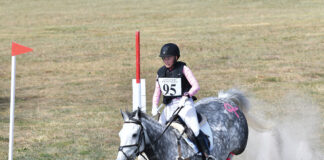
If you’re planning to go to riding camp this summer, thinking about safety might be boring, but it’s something you should consider before packing your suitcase. After all, you don’t want to be the kid who falls off the first day of camp, breaks her arm and spends the rest of the summer wearing a cast and watching everyone else have fun riding.
Wear safe riding gear
If you don’t have your own riding helmet, invest in one. You can buy an inexpensive schooling helmet that costs around $40 at the local tack and feed store. Isn’t your head worth $40? We think so! Make sure you wear the helmet whenever you’re mounted.
It’s also a good idea to wear it when you’re handling the camp horses. Remember, you don’t know these horses at all and you don’t know how they behave.
Take well-fitting jeans or breeches and a pair of boots with a heel with you to keep you safe in the saddle. If you plan to jump while you’re at camp, bringing a body protector with you is a good idea. Again, you don’t know the camp horses very well and you could take a dive while jumping an unfamiliar horse.
And finally, a lightweight pair of gloves will prevent your hands from getting blisters which could make riding painful.
Meet the trainer
Before you book a bunk, find out who will be teaching you this summer. Your trainers should be experienced riders with teaching and showing experience. Riding accidents can happen when inexperienced trainers don’t know what they’re doing in the arena. All of the camp’s trainers should be old enough to be in college.
Safe horses
A camp’s horses may vary from year to year, but most of them should be safe, quiet mounts. If you think that a horse looks like he might be too much for you to ride, talk to the trainer about it. She should not force you to ride a horse if you feel nervous.
Unless you’re very experienced and used to riding loonies, stick to mild-mannered, well trained horses when you’re at camp.
Although camp is a place to push yourself and try new activities, don’t do something if you don’t feel confident. Don’t jump a three-foot six oxer on a horse you don’t know well if you’ve only jumped cross rails. Be sensible in the saddle or you might end up on the ground.
Check the tack
If a camp has a lot of horses, the tack may occasionally be neglected. It’s a smart idea to look at your camp horse’s saddle to make sure the billet straps aren’t worn out before you hop on his back. Check that his girth straps are secure and that any stitching isn’t coming undone. Also, make sure the bridle leather is supple and clean. You don’t want a strap snapping as you gallop at top speed toward a cross-country fence.
Secure surroundings
A camp should have an enclosed arena or field to ride in. It’s not a great idea to ride an unfamiliar horse in a gigantic field or out on a trail until you know him a bit better. Your first few camp lessons should take place in an arena or small paddock with a fence and a gate. When you get used to the camp’s horses and feel confident in the arena, you can march out the gate and go on a fun trail ride.
Stay healthy
You need plenty of energy at camp, so eat three meals a day and grab some healthy snacks when they’re offered. Drink lots of water to stay well hydrated. If it’s hot and you don’t drink much water, you could get dizzy and pass out.
Its lots of fun to stay up half the night gossiping with your bunk mates, but try to get a good night’s sleep so you have plenty of energy for riding the next day. Riding requires you to react quickly to different horsey situations, and if you’re feeling dozy you might not be able to sit a bad spook or prevent a run out.
This article originally appeared in the March/April 2011 issue of Young Rider Magazine. Click here to subscribe.






Great advice for a fun time.